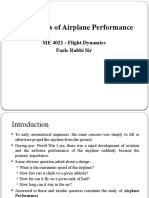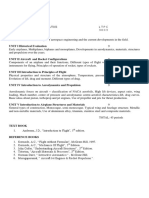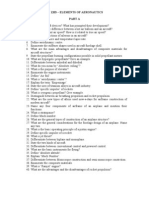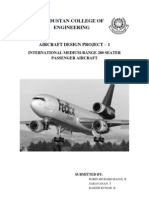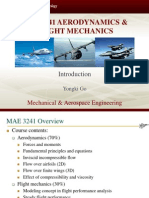Aerodynamics & Space Dynamics: Gate Aerospace
Aerodynamics & Space Dynamics: Gate Aerospace
Uploaded by
kkkrajaCopyright:
Available Formats
Aerodynamics & Space Dynamics: Gate Aerospace
Aerodynamics & Space Dynamics: Gate Aerospace
Uploaded by
kkkrajaOriginal Description:
Original Title
Copyright
Available Formats
Share this document
Did you find this document useful?
Is this content inappropriate?
Copyright:
Available Formats
Aerodynamics & Space Dynamics: Gate Aerospace
Aerodynamics & Space Dynamics: Gate Aerospace
Uploaded by
kkkrajaCopyright:
Available Formats
AERODYNAMICS &
SPACE DYNAMICS
GATE AEROSPACE
Prateek Tyagi Second Edition
GATE 2019
Organizing INSTITUTE :
Iit MADRAS
AEROSPACE
ENGINEERING
Join GATE AEROPSACE DISCUSSSION FORUM on Facebook and clear all your doubts
www.goodwillgate2iit.com +91 – 9933949303 / 7338451418
Aerodynamics Syllabus
Core Topics:
Basic Fluid Mechanics: Conservation laws: Mass, momentum
(Integral and differential form); Potential flow theory: sources,
sinks, doublets, line vortex and their superposition; Viscosity,
Reynold's number.
Airfoils and wings: Airfoil nomenclature; Aerodynamic
coefficients: lift, drag and moment; Kutta-Joukoswki theorem;
Thin airfoil theory, Kutta condition, starting vortex; Finite wing
theory: Induced drag, Prandtl lifting line theory; Critical and drag
divergence Mach number.
Compressible Flows: Basic concepts of compressibility,
Conservation equations; One dimensional compressible flows,
Fanno flow, Rayleigh flow; Isentropic flows, normal and oblique
shocks, Prandtl-Meyer flow; Flow through nozzles and diffusers.
Special Topics:
Elementary ideas of viscous flows including boundary layers;
Wind Tunnel Testing:
Measurement and visualization techniques.
www.goodwillgate2iit.com +91 – 9933949303 / 7338451418
Aerodynamics Year Wise Analysis
No of Total
Year Topics (1 marks + 2 marks)
Questions Marks
Basic Fluid mechanics and
conservation eq. (1 + 1)
Ideal potential flow (1 + 0)
Thin airfoil theory (1 + 0)
1M : 6
2018 Low Speed Aerodynamics 18
2M : 6 (0 + 1)
High lift devices and NACA
airfoils (1 + 0)
Gas Dynamics (2 + 4)
Basic Fluid mechanics and
conservation eq. (2 + 4)
1M : 5 Low Speed Aerodynamics
2017 (1 + 0) 19
2M : 7
Finite wing theory (0 + 1)
Gas Dynamics (2 + 2)
Basic Fluid mechanics and
conservation eq. (1 + 0)
Ideal potential flow (1 + 1)
15
Thin airfoil theory (0 + 1)
Low Speed Aerodynamics
1M : 7
2016 (1 + 0)
2M : 4 Finite wing theory (0 + 1)
High lift devices and NACA
airfoils (1 + 0)
High Speed Airfoils (1 + 0)
Gas Dynamics (2 + 1)
Basic Fluid mechanics and
conservation eq. (1 + 1)
Ideal potential flow (0 + 1)
Thin airfoil theory (0 + 2)
1M : 7 Low Speed Aerodynamics
2015 (2 + 0) 19
2M : 6
Finite wing theory (1 + 0)
High lift devices and NACA
airfoils (2 + 0)
Gas Dynamics (1 + 2)
Basic Fluid mechanics and
1M : 5
2014 conservation eq. (1 + 3) 21
2M : 8 Ideal potential flow (1 + 0)
www.goodwillgate2iit.com +91 – 9933949303 / 7338451418
Low Speed Aerodynamics
(0 + 1)
Finite wing theory (0 + 1)
High lift devices and NACA
airfoils (1 + 0)
High Speed Airfoils (0 + 1)
Gas Dynamics (2 + 2)
Basic Fluid mechanics and
conservation eq. (1 + 1)
Ideal potential flow (1 + 1)
1M : 5
2013 Thin airfoil theory (0 + 2) 19
2M : 7 Finite wing theory (0 + 1)
High Speed Airfoils (2 + 0)
Gas Dynamics (1 + 2)
Basic Fluid mechanics and
conservation eq. (1 + 2)
Ideal potential flow (1 + 0)
Thin airfoil theory (0 + 1)
1M:6
2012 Low Speed Aerodynamics 16
2M:5 (1 + 0)
Finite wing theory (1 + 0)
High Speed Airfoils (1 + 0)
Gas Dynamics (1 + 2)
Basic Fluid mechanics and
conservation eq. (0 + 2)
Ideal potential flow (1 + 0)
Low Speed Aerodynamics
1M:4
2011 (1 + 0) 22
2M:9 Finite wing theory (0 + 4)
High lift devices and NACA
airfoils (2 + 0)
Gas Dynamics (0 + 3)
Basic Fluid mechanics and
conservation eq. (3 + 1)
1M:5 Ideal potential flow (1 + 2)
2010 19
2M:7 Thin airfoil theory (0 + 1)
Finite wing theory (0 +1)
Gas Dynamics (1 + 2)
Basic Fluid mechanics and
conservation eq. (0 + 2)
Ideal potential flow (1 + 1)
Thin airfoil theory (1 + 0)
1M:4
2009 Low Speed Aerodynamics 16
2M:6 (0 + 1)
Finite wing theory (0 + 1)
High lift devices and NACA
airfoils (1 + 0)
www.goodwillgate2iit.com +91 – 9933949303 / 7338451418
Gas Dynamics (1 + 1)
Basic Fluid mechanics and
conservation eq. (0 + 1)
Ideal potential flow (1 + 1)
Thin airfoil theory (0 + 2) 30
2008 1M:4
Finite wing theory (0 + 3) (Total 150
(85 questions) 2M:13 High lift devices and NACA marks)
airfoils (2 + 0)
High Speed Airfoils (0 + 3)
Gas Dynamics (1 + 3)
Basic Fluid mechanics and
conservation eq. (0 + 3)
Ideal potential flow (0 + 2) 20
2007 1M:4
Thin airfoil theory (1 + 0) (Total 150
(85 questions) 2M:8 Finite wing theory (0 + 2) marks)
High Speed Airfoils (1 + 0)
Gas Dynamics (2 + 1)
www.goodwillgate2iit.com +91 – 9933949303 / 7338451418
TABLE OF CONTENT
1. Conservation Laws and Ideal Potential Flow 1 – 28
2. General Thin Airfoil Theory 29 – 41
3. Finite wing Theory 42 - 59
4. Low Speed Aerodynamics 60 – 80
5. High Lift Devices and NACA Airfoils 81 – 90
6. High Speed Airfoils 91 – 102
7. Linearized Supersonic Flow 103 – 107
8. Gas Dynamics 108 – 147
GATE and Additional questions
Exercise at the end of each Chapter
Previous year GATE questions solved
www.goodwillgate2iit.com +91 – 9933949303 / 7338451418
Chapter 2
GENERAL THIN AIRFOIL THEORY
2.1 ASSUMPTIONS
1. The airfoil is thin, so that its shape is effectively that of its camber line and also that
the camber line shape deviates very slightly from the chord line.
2. Theory is resisted to low angle of attack.
3. The flow direction is always tangential to the surface of the airfoil.
The camber line is replaced by a line of variable vorticity so that the total circulation about
the chord is sum of vortex element.
where, ϒ is the distribution of vorticity over the element of camber line ds and circulation is
taken positive in the anti-clockwise direction.
NOTE:
= =
= = ds
=
i.e. change of circulation per unit area is vorticity.
Basic assumptions of theory permit the variation of vorticity along the camber line assumed
to be same as the variation along the OX axis.
Hence for unit span of this section, the lift is given by
Lift = ρU N / unit span
L = ρU = ρU --------------------- (1)
The net lift acting on the body can be written as,
www.goodwillgate2iit.com +91 – 9933949303 / 7338451418
L=
L= --------------------- (2)
Comparing equation 1 and 2, we get,
ρU
At small AOA cosα = 1
L= = ρU
Moment about Leading edge
(Nose down pitching moment is negative)
www.goodwillgate2iit.com +91 – 9933949303 / 7338451418
----------------------------------------------------------------------------------------------------------------
----------------------------------------------------------------------------------------------------------------
----------------------------------Pages missing in sample copy-------------------------------------
----------------------------------------------------------------------------------------------------------------
----------------------------------------------------------------------------------------------------------------
NOTE:
1. Angled Trailing edge :
Since two streamlines cannot each other and it is impossible to have two velocities in
two different directions at single point.
Therefore, Angled Trailing edge must be a stagnation point.
i.e. V1 = V2 = 0
hence,
=0
2. Cusped trailing edge :
i.e. V1 = V2
Hence,
=0
The above condition expressed in terms of the strength of the vortex sheet is known as
KUTTA CONDITION.
www.goodwillgate2iit.com +91 – 9933949303 / 7338451418
----------------------------------------------------------------------------------------------------------------
----------------------------------------------------------------------------------------------------------------
----------------------------------Pages missing in sample copy-------------------------------------
----------------------------------------------------------------------------------------------------------------
----------------------------------------------------------------------------------------------------------------
Aerodynamic co-efficients for a flat plate airfoil
(1). Lift coefficient
L= = ρU
x= , dx =
L=
L=ρ
ρ =ρ
=2
(2). Pitching Moment at Leading edge
ρ =
Substituting value of in above expression and integrating, we get
=
NOTE:
(1)
= +
www.goodwillgate2iit.com +91 – 9933949303 / 7338451418
Center of pressure as the point about which the moment are zero. For symmetric airfoil
the center of pressure is at the quarter-chord point. Also, Point on an airfoil where
moments are independent of angle of attack is called the aerodynamic center. The
moment about quarter chord point is zero for all values of α. Hence for symmetric
airfoil, the quarter chord point is both the center of pressure and the aerodynamics
center.
(2)
Substituting value of in above expression and integrating, we get
=
----------------------------------------------------------------------------------------------------------------
----------------------------------------------------------------------------------------------------------------
----------------------------------Pages missing in sample copy-------------------------------------
----------------------------------------------------------------------------------------------------------------
----------------------------------------------------------------------------------------------------------------
2.7 KUTTA – ZOUKOWSKI’S TRANSFORMATION
Of all the transformation conformal in nature, the simplest transformation to
produce conformal shape is KZT.
Where, b is constant
The transformation can be applied to all the other streamlines for producing
corresponding streamlines in ξ – plane flowing around the airfoil
It transforms cylinder from the Z – plane to a special set of airfoils in ξ – plane. Such
that the airfoils are known as Joukowsky’s airfoils.
www.goodwillgate2iit.com +91 – 9933949303 / 7338451418
2.8 LIFT GENERATED BY ZOUKOWSKI’S AIRFOILS
where,
Note: For flat plate airfoil, e = 0,
Hence,
For small α,
www.goodwillgate2iit.com +91 – 9933949303 / 7338451418
Q. Calculate the theoretical lift coefficient of a Zoukowski’s airfoil t/c = 0.2 and 2% camber
set at 40 incidence in a 2D irrotational flow.
Ans: 0.7946
Given:
= 2.292
----------------------------------------------------------------------------------------------------------------
----------------------------------------------------------------------------------------------------------------
----------------------------------Pages missing in sample copy-------------------------------------
----------------------------------------------------------------------------------------------------------------
----------------------------------------------------------------------------------------------------------------
www.goodwillgate2iit.com +91 – 9933949303 / 7338451418
GATE and Additional
objective questions
Q1. The rate of change of moment coefficient with respect to the angle of attack, at
half chord point of a thin airfoil, as per approximations frm the thin airfoil theory is
(a) π/4 radian-1 (b) π/2 radian-1 (c) πradian-1 (d) 2π radian-1 [GATE 2016]
Ans: (b) π/2 radian-1
Pitching Moment at half chord point of a thin airfoil
x= , dx =
Q2. Consider a symmetric airfoil at an angle of attack of 40. Using thin airfoil theory, the
magnitude of the moment coefficient about the leading edge is [GATE 2008]
(a) 2π (b) π (c) (d)
Ans: (d)
Where, α is in radians
www.goodwillgate2iit.com +91 – 9933949303 / 7338451418
----------------------------------------------------------------------------------------------------------------
----------------------------------------------------------------------------------------------------------------
----------------------------------Pages missing in sample copy-------------------------------------
----------------------------------------------------------------------------------------------------------------
----------------------------------------------------------------------------------------------------------------
Chapter 7
LINEARIZED SUPERSONIC FLOW
7.1 INTRODUCTION
The linearized perturbation velocity potential equation is given by
The above equation holds for both subsonic and supersonic flows.
7.2 LINEARIZED SUPERSONIC PRESSURE
COEFFICIENT FORMULA
It is the linearized supersonic pressure coefficient, and it states that C P is directly
proportional to the local surface inclination with respect to the freestream. It holds for any
slender two – dimensional body where ϴ is small.
Note that ϴ is positive when measured above the horizontal, and negative when measured
below the horizontal.
www.goodwillgate2iit.com +91 – 9933949303 / 7338451418
Note that ; hence, for supersonic flow, CP decreases as
increases.
This is in contrast with subsonic flow, where ; hence for subsonic
flow, CP increases as increases.
Both results predict from either side.
7.3 APPLICATION TO SUPERSONIC AIRFOILS
www.goodwillgate2iit.com +91 – 9933949303 / 7338451418
----------------------------------------------------------------------------------------------------------------
----------------------------------------------------------------------------------------------------------------
----------------------------------Pages missing in sample copy-------------------------------------
----------------------------------------------------------------------------------------------------------------
----------------------------------------------------------------------------------------------------------------
7.4 A FLAT PLATE AT ANGLE OF ATTACK IN A
SUPERSONIC FLOW
Looking at this picture, the lower surface of the plate is a compression surface inclined at
the angle α into the freestream, given by
Since the surface inclination angle is constant along the entire lower surface, is a
constant value over the lower surface.
Similarly, the top surface is an expansion surface inclined at the abgle α away frim the
freestream, given by
is a constant value over the upper surface.
The normal force coefficient cn be obtained from
www.goodwillgate2iit.com +91 – 9933949303 / 7338451418
----------------------------------------------------------------------------------------------------------------
----------------------------------------------------------------------------------------------------------------
----------------------------------Pages missing in sample copy-------------------------------------
----------------------------------------------------------------------------------------------------------------
----------------------------------------------------------------------------------------------------------------
Q1. Consider a thin flat plate airfoil at a small angle α to an oncoming supersonic stream of
air. Assuming the flow to be Inviscid, is [GATE 2013]
(a) zero (b) independent of α
(c) proportional to α (d) proportional to α2
Ans: (b) independent of α
We know,
Hence, it is independent of α
Q2. Using linearized theory, calculate the lift and drag coefficients for a flat plate at a 5 0
angle of attack in a Mach 3 flow.
Ans:
----------------------------------------------------------------------------------------------------------------
----------------------------------------------------------------------------------------------------------------
----------------------------------Pages missing in sample copy-------------------------------------
----------------------------------------------------------------------------------------------------------------
----------------------------------------------------------------------------------------------------------------
www.goodwillgate2iit.com +91 – 9933949303 / 7338451418
DREAM BIG
BE AN IITian!
Textbooks for GATE AEROSPACE
You might also like
- Best Study Material For Aerospace Engineering GateDocument2 pagesBest Study Material For Aerospace Engineering GateAbrar Nizami56% (9)
- GATE AEROSPACE FormulasDocument38 pagesGATE AEROSPACE FormulasMust Watch79% (14)
- High Speed Wind Tunnel Testing Alan PopeDocument481 pagesHigh Speed Wind Tunnel Testing Alan PopeDipanjan Barman100% (4)
- Aircraft General Knowledge (WEIGHT & BALANCE)Document37 pagesAircraft General Knowledge (WEIGHT & BALANCE)Azuma Cenation Azra100% (1)
- Aircraft Design Project II: Business Jet DesigningDocument54 pagesAircraft Design Project II: Business Jet Designingu2b11517100% (1)
- 4.torque Diagram of The WingDocument3 pages4.torque Diagram of The WingBalaji AeroNo ratings yet
- Composites Part A - Applied Science and Manufacturing Volume 35 Issue 7-8 2004 (Doi 10.1016/j.compositesa.2004.01.014) J. Cugnoni Th. Gmür A. Schorderet - Identification by Modal Analysis of CompoDocument11 pagesComposites Part A - Applied Science and Manufacturing Volume 35 Issue 7-8 2004 (Doi 10.1016/j.compositesa.2004.01.014) J. Cugnoni Th. Gmür A. Schorderet - Identification by Modal Analysis of CompokkkrajaNo ratings yet
- Mil STD 975mDocument499 pagesMil STD 975mJuan David Bolaños Aguilar100% (1)
- Propulsion - Scribd Gate PDFDocument31 pagesPropulsion - Scribd Gate PDFKarthic M PanickarNo ratings yet
- Space Dynamics - Problem Sheet Level 2Document2 pagesSpace Dynamics - Problem Sheet Level 2Mohit kumar0% (1)
- Aerodynamics - Problem Sheet Level 1Document4 pagesAerodynamics - Problem Sheet Level 1Komal joshi100% (2)
- Flight Mechanics Sample Complete PDFDocument27 pagesFlight Mechanics Sample Complete PDFkkkraja75% (4)
- Gate Flight Mechanics by VayushastraDocument36 pagesGate Flight Mechanics by Vayushastraudaykumar100% (5)
- GATE Aero-Propulsion by IGCDocument256 pagesGATE Aero-Propulsion by IGCParth PatelNo ratings yet
- Gate Aerospace Flight MechanicsDocument11 pagesGate Aerospace Flight Mechanicsvenkatakrishnan srinivasanNo ratings yet
- FLIGHTMECHANICSDocument48 pagesFLIGHTMECHANICSvenkatakrishnan srinivasanNo ratings yet
- A Quick Guide of Aerospace EngineeringDocument13 pagesA Quick Guide of Aerospace EngineeringThe Galactic Wolf100% (1)
- Gate Aerospace 2010 SolutionDocument35 pagesGate Aerospace 2010 SolutionJackobNo ratings yet
- Lift Line TheoryDocument19 pagesLift Line TheoryMuzakkir Sharieff100% (1)
- Igc - Gate - Aerospace - Space DynamicsDocument53 pagesIgc - Gate - Aerospace - Space Dynamicsvenkatakrishnan srinivasanNo ratings yet
- V-N DiagramDocument37 pagesV-N DiagramReji RejishNo ratings yet
- AERODYNAMICSDocument60 pagesAERODYNAMICSvenkatakrishnan srinivasanNo ratings yet
- Aircraft Design Report FinalDocument29 pagesAircraft Design Report Finalapi-287948833No ratings yet
- ADP 1 LAB ManualDocument54 pagesADP 1 LAB ManualdhanajayanNo ratings yet
- Flight Vehicle Design - III YearDocument51 pagesFlight Vehicle Design - III Yeargvsmsurya100% (1)
- Elements of Airplane Performance: ME 4021: Flight Dynamics Fazle Rabbi SirDocument42 pagesElements of Airplane Performance: ME 4021: Flight Dynamics Fazle Rabbi SirRafiqul IslamNo ratings yet
- Aircraft Structures Notes 1Document200 pagesAircraft Structures Notes 1WizardWannabeNo ratings yet
- Aircraft Structure-1 Scanned NotesDocument128 pagesAircraft Structure-1 Scanned NotesPrasanth100% (1)
- Aircraft Design Project 2Document117 pagesAircraft Design Project 2Mahesh J Rao85% (13)
- Volare Questions - AerodynamicsDocument54 pagesVolare Questions - AerodynamicsJohn VuNo ratings yet
- UAV Design 25kg CategoryDocument22 pagesUAV Design 25kg CategoryPrateek JainNo ratings yet
- Team 7 Adp 1 Project ReportDocument124 pagesTeam 7 Adp 1 Project Reportravi kumar100% (1)
- ADDocument491 pagesADSwagat DasNo ratings yet
- Space Dynamics PDFDocument11 pagesSpace Dynamics PDFrakhi sonu2000100% (2)
- Elements of AeronauticsDocument109 pagesElements of Aeronauticsmrkmrk90078% (9)
- ME3608 Aeroelasticity #1Document31 pagesME3608 Aeroelasticity #1djtj89No ratings yet
- Propulsion Question Bank 1Document14 pagesPropulsion Question Bank 1aeroherozNo ratings yet
- Sae - Uav - Design - Report - RcaDocument30 pagesSae - Uav - Design - Report - RcaShaurya Gupta50% (2)
- Finite Element MethodsDocument2 pagesFinite Element MethodsDivya TadepalliNo ratings yet
- Stability Augmentation SystemsDocument4 pagesStability Augmentation SystemsSuraj ChaurasiyaNo ratings yet
- Aerodynamics II NotesDocument166 pagesAerodynamics II NotesAlexShearNo ratings yet
- Aeronautical Question PaperDocument3 pagesAeronautical Question PaperGinu ThomasNo ratings yet
- Aircraft Design Project - 280 Seat TransportDocument108 pagesAircraft Design Project - 280 Seat TransportNick Fisette75% (4)
- Background On Aircraft AerodynamicsDocument8 pagesBackground On Aircraft AerodynamicsAbdelrahman NassifNo ratings yet
- MAE3241 Ch01 IntroductionDocument20 pagesMAE3241 Ch01 Introductionmblaskovich2010No ratings yet
- AE8502 AIRCRAFT STRUCTURES II Unit IIDocument24 pagesAE8502 AIRCRAFT STRUCTURES II Unit IIObli Kumaran L100% (1)
- Propulsion Sample CompleteDocument31 pagesPropulsion Sample CompleteTuba KhanNo ratings yet
- Elements of Gas Turbine Propulti - 12Document1 pageElements of Gas Turbine Propulti - 12priyanka_667739682No ratings yet
- Conference 2Document9 pagesConference 2Vikram C KNo ratings yet
- Math. Review: Dynamic Optimization: ECON2225 Economics of Population Changes (2019)Document26 pagesMath. Review: Dynamic Optimization: ECON2225 Economics of Population Changes (2019)wruNo ratings yet
- Assimilation Techniques 4 4dvarDocument9 pagesAssimilation Techniques 4 4dvarHim Kiran PaudelNo ratings yet
- Fluid DynamicsDocument44 pagesFluid Dynamicsbmk_cit5898No ratings yet
- ME265 MAI 1stLaw2ndLaw 6Document12 pagesME265 MAI 1stLaw2ndLaw 6jannatul ferdous provaNo ratings yet
- HT - D02-Heat Transfer Rate EquationsDocument62 pagesHT - D02-Heat Transfer Rate EquationsAlberto Ruiz Rodriguez-RubioNo ratings yet
- 2016 Updated Questions Physics XII PDFDocument29 pages2016 Updated Questions Physics XII PDFMohib UddinNo ratings yet
- PHY.QP.BLUEPRINT.2425Document2 pagesPHY.QP.BLUEPRINT.2425Aman RajNo ratings yet
- CS Ramish220101062-7Document32 pagesCS Ramish220101062-7ramish.khan18112003No ratings yet
- New Family of Flux Limiter Function: H. Carrillo, E. Macca, C. Pares and G. RussoDocument7 pagesNew Family of Flux Limiter Function: H. Carrillo, E. Macca, C. Pares and G. RussoHugo CarrilloNo ratings yet
- MEN4133 RAC F19 Fall22Document6 pagesMEN4133 RAC F19 Fall22bilalagha884No ratings yet
- CS_ChEDocument6 pagesCS_ChESakib ShaikhNo ratings yet
- Arrays and Strings AssignmentDocument2 pagesArrays and Strings AssignmentkkkrajaNo ratings yet
- Gate Aerospace Study Material and Online Test Series - Goodwill Gate2iitDocument6 pagesGate Aerospace Study Material and Online Test Series - Goodwill Gate2iitkkkraja100% (1)
- Aircraft Performance-2 PDFDocument6 pagesAircraft Performance-2 PDFkkkrajaNo ratings yet
- Aircraft StrucDocument17 pagesAircraft StrucnasetasuNo ratings yet
- Aerodynamics 3Document4 pagesAerodynamics 3kkkraja100% (1)
- NLHG - Sÿ R FG Ÿ 'Jlok N Fpo (Ÿ MLFMW L (Ÿ Hpiÿ K FMN - O: Biÿ Xÿ JW F - Bok H - BDocument3 pagesNLHG - Sÿ R FG Ÿ 'Jlok N Fpo (Ÿ MLFMW L (Ÿ Hpiÿ K FMN - O: Biÿ Xÿ JW F - Bok H - BkkkrajaNo ratings yet
- Compute The Cross (Vector) Product of Two VectorsDocument1 pageCompute The Cross (Vector) Product of Two VectorskkkrajaNo ratings yet
- Fake Companies ListDocument17 pagesFake Companies ListkkkrajaNo ratings yet
- Symmetric Bending of Laminated PlatesDocument3 pagesSymmetric Bending of Laminated PlateskkkrajaNo ratings yet
- Laplace Table PDFDocument2 pagesLaplace Table PDFkkkrajaNo ratings yet
- Analysis of Laminated Composite Plate Using MatlabDocument10 pagesAnalysis of Laminated Composite Plate Using Matlabkkkraja100% (1)
- Aerofoil MH70Document4 pagesAerofoil MH70kkkrajaNo ratings yet
- 7 EndConstraintDocument15 pages7 EndConstraintkkkrajaNo ratings yet
- How To Find A Prime Number With Maths Aptitude TricksDocument17 pagesHow To Find A Prime Number With Maths Aptitude TrickskkkrajaNo ratings yet
- On The Strength of The Carbon Nanotube-Based Space Elevator Cable: From Nano-To Mega-MechanicsDocument25 pagesOn The Strength of The Carbon Nanotube-Based Space Elevator Cable: From Nano-To Mega-MechanicskkkrajaNo ratings yet
- 19 MacCormack TechniqueDocument14 pages19 MacCormack TechniquekkkrajaNo ratings yet
- Creating Sparse Finite-Element Matrices in MATLAB Loren On The Art of MATLABDocument8 pagesCreating Sparse Finite-Element Matrices in MATLAB Loren On The Art of MATLABkkkrajaNo ratings yet
- 841 Atprime2Document4 pages841 Atprime2uzzy2No ratings yet
- Lab For AP ChemistryDocument8 pagesLab For AP ChemistryCliff LiuNo ratings yet
- Science Project of The SupernovaDocument14 pagesScience Project of The SupernovaRandomizm100% (1)
- Pembuatan Cis Dan Trans Kalium DioksalatodiakuokromatDocument10 pagesPembuatan Cis Dan Trans Kalium DioksalatodiakuokromatZulvana Anggraeni HarvianNo ratings yet
- Invoice: An ISO 9001:2008 CompanyDocument6 pagesInvoice: An ISO 9001:2008 CompanyBalajiPrakasamNo ratings yet
- Neubermethod PDFDocument164 pagesNeubermethod PDFchaitNo ratings yet
- Bresle Kit Chloride Test Kit Sp7310 d44Document3 pagesBresle Kit Chloride Test Kit Sp7310 d44sanmartinjNo ratings yet
- Scale Bars PDFDocument5 pagesScale Bars PDFKhaledSultanNo ratings yet
- 85-93 Ahmad Abdelrazaq - Foundation Design of The 151 Incheon Tower in A Reclamation AreaDocument9 pages85-93 Ahmad Abdelrazaq - Foundation Design of The 151 Incheon Tower in A Reclamation AreaMagdy BakryNo ratings yet
- Physics of The Impossible: A Scientific Exploration Into The World of Phasers, Force Fields, Teleportation, and Time Travel by Michio KakuDocument2 pagesPhysics of The Impossible: A Scientific Exploration Into The World of Phasers, Force Fields, Teleportation, and Time Travel by Michio KakuHomeroom Tab0% (1)
- 08 Absorption and StrippingDocument68 pages08 Absorption and StrippingEK63No ratings yet
- ME 316 - OutlineDocument2 pagesME 316 - OutlineSaud AlasmariNo ratings yet
- Nuclear Force LPDocument9 pagesNuclear Force LPAnonymous NXn6teNo ratings yet
- SpinDocument21 pagesSpinRiyan AngelaNo ratings yet
- Super ConductivityDocument26 pagesSuper ConductivityAFTABALI SALIM MAMTULAYNo ratings yet
- cs2 PDFDocument84 pagescs2 PDFAjayNo ratings yet
- Electro ChemistryDocument30 pagesElectro ChemistryPower booster100% (1)
- Experiment 6Document4 pagesExperiment 6Dean MercadoNo ratings yet
- Seminar Cover Page PDFDocument7 pagesSeminar Cover Page PDFSouradeep SenNo ratings yet
- 1 GR 12 Maths Functions Questions AnswersDocument5 pages1 GR 12 Maths Functions Questions AnswersNuurani100% (1)
- ERfinder Posts PDFDocument35 pagesERfinder Posts PDFpic2007No ratings yet
- A Review On Concrete Filled Steel Tubes Column: December 2015Document7 pagesA Review On Concrete Filled Steel Tubes Column: December 2015Dony DoanxNo ratings yet
- Transfer TripletsDocument1 pageTransfer TripletsrobinlpaulNo ratings yet
- Hw2ans PDFDocument5 pagesHw2ans PDFkimyNo ratings yet
- Basic ConceptsDocument31 pagesBasic ConceptsZunaira NoreenNo ratings yet
- Dynamic Analysis of Intake Towerr PDFDocument5 pagesDynamic Analysis of Intake Towerr PDFchutton681No ratings yet
- Electromagnetic TheoryDocument76 pagesElectromagnetic TheorybenoNo ratings yet
- CHAPTER 9 - Lecture NotesDocument40 pagesCHAPTER 9 - Lecture NotesAlex100% (2)
- Topic 2 Non Steady State DiffusionDocument5 pagesTopic 2 Non Steady State DiffusionLorraineNo ratings yet

























